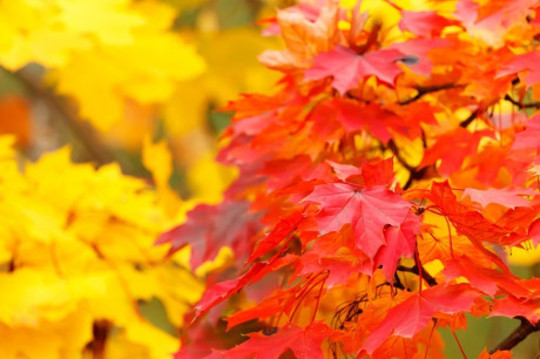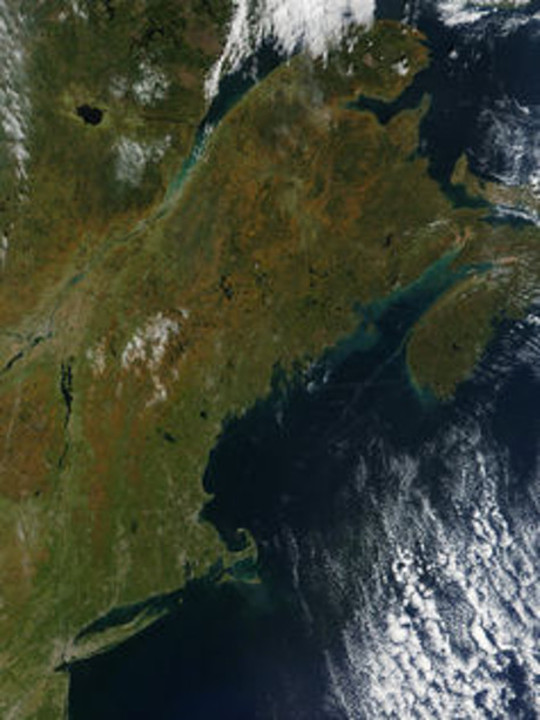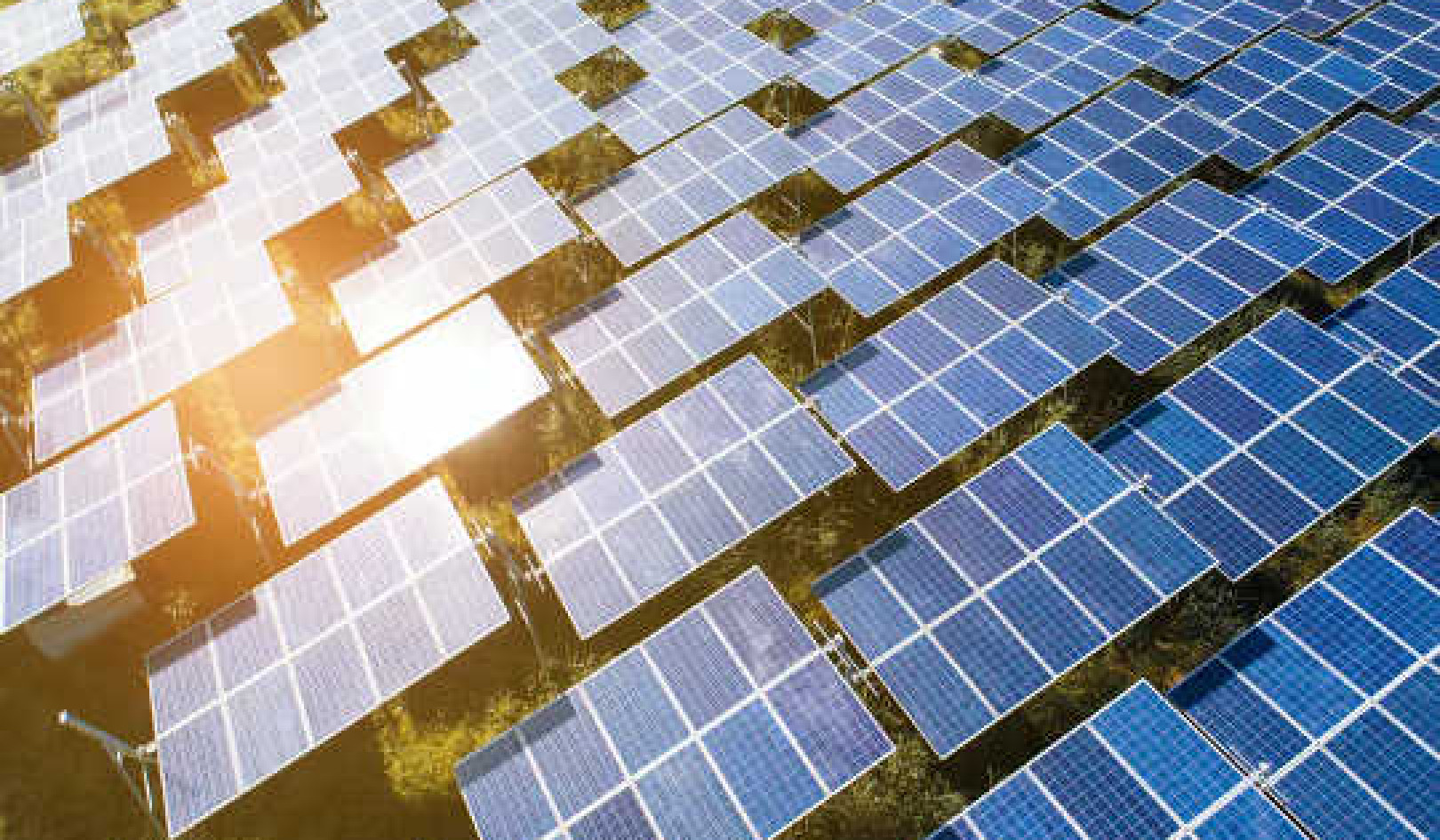 Red and yellow now … brown in the future?
Red and yellow now … brown in the future?
One of nature’s most spectacular events occurs every autumn, when the leaves of hardwood trees burst into brilliant color before falling to the ground. These autumnal displays in the eastern United States, Europe, eastern Asia and a few locales in South America and New Zealand entice people to experience nature in all its raw beauty.
Leaf peeping can pump hundreds of millions of tourist dollars into the economies of particularly colorful areas. But now climate change hovers in the background, threatening to alter future versions of this annual color show.
Business As Usual
Tree leaves turn color in the fall in response to shorter days and cooler temperatures. In August and September, trees begin an orderly process of leaf senescence – or dying – characterized by the loss of chlorophyll, the green pigment that plants use to capture light for photosynthesis.
Some species, such as dogwoods, red maples and red oaks, begin to make anthocyanins, the pigments that give leaves their bright red color. Other trees, such as birches, tulip poplars and beech, don’t make anthocyanins. Instead, when their chlorophyll breaks down, pigments hidden during the summer months become visible. Called carotenoids and xanthophylls, they’re the pigments responsible for producing orange and yellow leaves.
Too Warm, Too Cool
If the fall is cool, trees develop leaf color earlier. Warmer years, the display of color is delayed. In a world warmed by climate change, the onset of colors would always come later in the season. Some trees are more sensitive to temperature than others. As the climate warms, the finely-tuned timing of the fall’s color display may lose its synchronization. Rather than the well-timed symphony of color that we’re used to now, we might see unsynchronized patches as each species changes over the course of the season.
Warmer temperatures may also allow pests such as insects, fungi or bacteria – not to mention exotic tree species such as the Princess Tree – to move farther north than usual. These pests could alter the composition of the forest, much as when chestnuts were eliminated by blight 100 years ago. If the species composition of future forests changes in response to climate change, the quality of the fall foliage display will be quite different from what we see now.
Sugars From Sun
Sunshine plays a role here too. Later in the season, the days are shorter and the sun is lower in the sky due to the earth’s tilt. This reduced sunlight slows down the process of photosynthesis and lowers sugar reserves. Without those sugars to stimulate the synthesis of anthocyanins, we get duller red leaves.
Too Wet, Too Dry
Global climate change might also alter precipitation amounts and timing. Too much rain lowers the intensity of fall color – not because it washes out the colors (an old wives’ tale), but rather because cloudy skies and low light cut down on photosynthesis and production of those vital anthocyanins. Conversely, drought causes trees to drop their leaves prematurely before they get a chance to turn color.
Nitrogen is another factor that could mute the color display. Excess levels, which can result from pollution and increased precipitation, also reduce anthocyanin production. Again the result is less red leaf color. We may already be seeing less vibrant red fall displays than those prior to industrialization, since most eastern forests today get from two to seven times the natural input of nitrogen.
Migrating Trees
 Fall foliage display as seen from space. (NASA’s Earth Observatory)
Fall foliage display as seen from space. (NASA’s Earth Observatory)
If it becomes too warm or too dry for some tree species, they may have to migrate to more suitable habitats. Individual trees, of course, can’t pick up and move in response to climatic conditions. But the trees in inhospitable areas would die out and seedlings would take hold in new cooler areas.
In Vermont, where temperatures have increased by 2.5F (1.5C) in the past 50 years, hardwood trees have migrated around 328ft (100m) upslope, where it’s cooler. For trees on flatter terrain, warmer temperatures will force them to migrate north. Sugar maple, one of the major fall color trees in New England, may move right out of the United States into Canada. What will autumn in New England feel like without the brilliant red colors we’re used to? Such migrations will alter the composition of our forests forever. A new fall color balance will eventually emerge.
Don’t Forget Carbon Dioxide
Of course, an increase in the amount of carbon dioxide in Earth’s atmosphere is one of the reasons the climate is warming in the first place. Trees will need to adapt as carbon dioxide levels continue to rise over the coming decades. Research suggests that more CO2 might actually enhance fall colors. So score one point for global warming – even if this one factor won’t tip the balance.
Catch This Show While You Can
Global climate change will not eliminate fall leaf color, but the best displays will move northward and upward in elevation in response to warming. For forests in their present location, fall foliage displays will occur later in the season and may last longer, but will be of diminished quality due to less intense red colors. The fall foliage displays that our grandchildren will see at the end of this century will not be the ones we see today.
This article was originally published on The Conversation
Read the original article.
About the Author
 Howard Neufeld is a Professor of Physiological Plant Ecology at Appalachian State University. His laboratory is focused on the physiological ecology of plants, including such topics as water relations and gas exchange patterns, air pollution, understory herbs and the ecology of invasive plants. In recent years we have had a large research effort geared towards understanding the impacts of tropospheric ozone on plants native to Great Smoky Mountains National Park.
Howard Neufeld is a Professor of Physiological Plant Ecology at Appalachian State University. His laboratory is focused on the physiological ecology of plants, including such topics as water relations and gas exchange patterns, air pollution, understory herbs and the ecology of invasive plants. In recent years we have had a large research effort geared towards understanding the impacts of tropospheric ozone on plants native to Great Smoky Mountains National Park.
Disclosure Statement: Howard Neufeld does not work for, consult to, own shares in or receive funding from any company or organisation that would benefit from this article, and has no relevant affiliations.
Recommended Book:
The Earth Only Endures: On Reconnecting with Nature and Our Place in It
by Jules Pretty.
 For most of human history, we have lived our daily lives in a close relationship with the land. Yet now, for the first time, more people are living in urban rather than rural areas, bringing about an estrangement. This book, by acclaimed author Jules Pretty, is fundamentally about our relationship with nature, animals and places. A series of interlinked essays leads readers on a voyage that weaves through the themes of connection and estrangement between humans and nature. The journey shows how our modern lifestyles and economies would need six or eight Earths if the entire world's population adopted our profligate ways. Jules Pretty shows that we are rendering our own world inhospitable and so risk losing what it means to be human: unless we make substantial changes, Gaia threatens to become Grendel. Ultimately, however, the book offers glimpses of an optimistic future for humanity, in the very face of climate change and pending global environmental catastrophe.
For most of human history, we have lived our daily lives in a close relationship with the land. Yet now, for the first time, more people are living in urban rather than rural areas, bringing about an estrangement. This book, by acclaimed author Jules Pretty, is fundamentally about our relationship with nature, animals and places. A series of interlinked essays leads readers on a voyage that weaves through the themes of connection and estrangement between humans and nature. The journey shows how our modern lifestyles and economies would need six or eight Earths if the entire world's population adopted our profligate ways. Jules Pretty shows that we are rendering our own world inhospitable and so risk losing what it means to be human: unless we make substantial changes, Gaia threatens to become Grendel. Ultimately, however, the book offers glimpses of an optimistic future for humanity, in the very face of climate change and pending global environmental catastrophe.
Click here for more info and/or to order this book on Amazon.
























